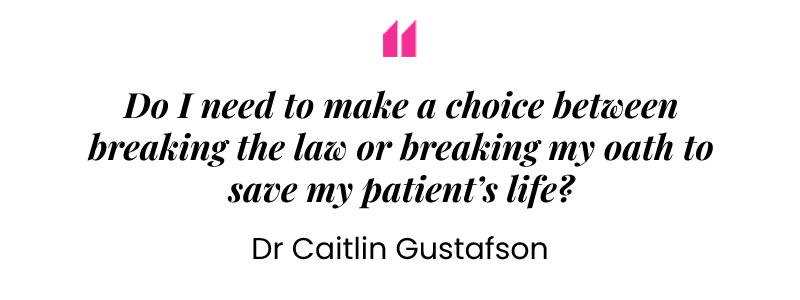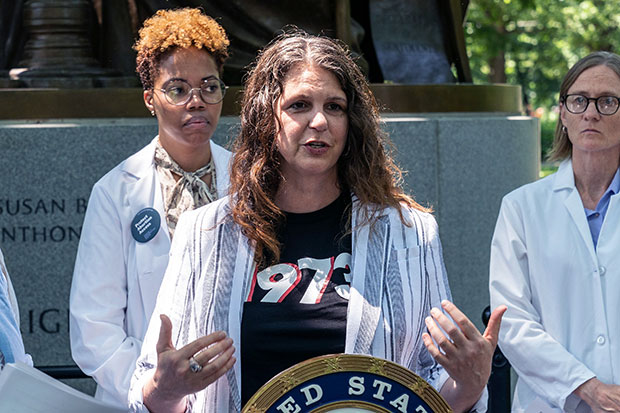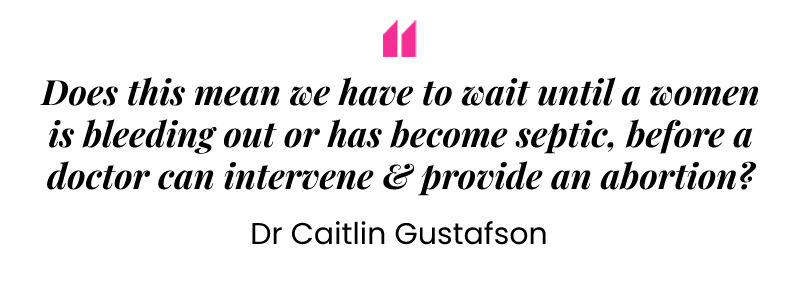
The Supreme Court overturned Roe V Wade and thanks to that ruling, women and doctors are now facing the fallout in Idaho where abortion rights have been eviscerated. The state known mostly until recently for its stunning ski hills, today has the distinction of being singled out by Attorney General Merrick Garland as the first in the Department of Justice’s efforts to protect abortion access, at least in emergency situations.
That’s because Idaho has not one but two onerous new abortion laws which make getting an abortion in the state , even in health emergencies, almost impossible. There’s the new fetal heartbeat abortion law, banning abortions after six weeks of pregnancy, which went into effect August 12, plus there is a total abortion ban which becomes law on August 25. That has left doctors in the state, Like Caitlin Gustafson, struggling to contend with both the intended and unintended consequences of the extreme new laws banning abortions. The new laws outlaw abortions except in cases of reported rape and incest or if the life of the mother is threatened by ” imminent death.”

The big catch for physicians is that ” imminent death” is not defined. Not only will Idaho women with unwanted pregnancies have to leave the state to obtain abortions, but women with wanted pregnancies who miscarry, who have ectopic pregnancies, or who experience serious complications are now at risk of life-threatening illnesses or death if doctors can’t perform abortions.

That’s because as Dr. Caitlin Gustafson, an Idaho family physician who provides obstetric care, explains, abortion is the absolutely necessary standard of care to save a woman’s health or life under those exact medical conditions. “We aren’t going to be able to make the best medical decisions for our patients,” Dr. Gustafson tells HollywoodLife with frustration.
Idaho’s new laws only allow for abortions to prevent the “imminent death” of the mother or if a woman or girl has been raped or is the victim of incest and has reported it to the police or child services, and can present that legal documentation to a doctor. Furthermore, neither Idaho’s heartbeat abortion law nor the upcoming total ban, give any definition of what “imminent death” means.

“Does this mean that we have to wait until a woman is bleeding out [with a hemorrhage] or has become septic [from an infection in her uterus]?” Dr. Gustafson asks, pointing out that doctors in Idaho don’t know when they can perform an abortion, without facing the risk of being criminally prosecuted. Dr. Gustafson also doesn’t know if she and other Idaho doctors can treat a woman suffering from a dangerous ectopic pregnancy, in which a fertilized egg has lodged and is growing in a woman’s fallopian tube.
“An ectopic pregnancy will never result in a baby,” she explains since no embryo or fetus can develop into a baby in a fallopian tube. “You want to treat ectopic pregnancies before they rupture the fallopian tube and become life-threatening. A woman can bleed to death.” Nevertheless, Idaho doctors don’t know if it’s now legal to save a woman before her fallopian tube ruptures and she risks dying.
She also wonders if a pregnant woman’s water breaks at—for example—at week 18 or 19 of the pregnancy, long before a fetus is viable, how long must she or other doctors wait for an infection to grow and spread in a woman’s uterus, since this will always happen under these circumstances. “Do we intervene when a woman has a fever or do we have to wait until she has multi-organ failure?” she questions.
“We are being asked to put patients’ lives at risk,” she says pointing out that doctors are trained to give medical treatment as early in a medical crisis as possible to prevent people from actually getting close a life-threatening scenario.
“It’s confusing to doctors and scary for patients,” she says, but the legal threats that Dr. Gustafson and all other Idaho doctors now face if they perform any abortion for any reason, are scary too. If Gustafson or any other Idaho physician is charged with performing an abortion, they face two to five years in jail, plus losing their medical licenses for at least six months. and potentially forever. As well, they can even be sued for $20,000 by a patient who has been given an abortion, and also by any of her close family members.
In fact, in Idaho, a rapist’s family can now sue the doctor who performs an abortion on a rape victim. The Idaho law is that extreme. It’s no wonder that Dr. Gustafson asks: “Do I want to face a criminal investigation, a prison sentence, and losing my medical license?” It’s a terrible choice for doctors who are trained to heal patients as safely and quickly as possible, not wait till they become critically ill before they can provide a life saving abortion.
The Idaho laws “are putting physicians in an absolutely untenable situation, between the training and commitment that they have made their entire career in medicine ,and facing criminalization by caring for their patients,” Rebecca Gibron, the CEO of Planned Parenthood of the Great Northwest, Hawaii, Alaska, Indiana, and Kentucky tells HollywoodLife. She believes that Idaho’s law utilizes the vague term of “imminent death”, with no explanation on purpose. “It makes it really difficult to determine when a physician can provide care.”

“Idaho’s anti-abortion laws are particularly egregious,” agrees Andrea Miller, the President of the National Institute of Reproductive Health. That’s because a doctor has to prove they needed to provide an abortion to a patient because she was at “imminent risk” of death. It’s called an “affirmative defense,” which she describes, as “sort of like you are guilty until you prove yourself not guilty.” She said, “Are you going to have to show that you had an expectation that a patient was so likely to die? 80 percent likely to die? 99.9 percent likely to die? It’s outrageous.”

She’s heartened by Attorney General Merrick Garland’s announcement that the Department of Justice had launched a lawsuit seeking a temporary and permanent injunction against at least part of the Idaho total abortion law, which takes effect August 25. Garland said the ban violates a federal law called the Emergency Medical Treatment and Labor Act (EMTALA), which requires all U.S. hospitals receiving Medicare funds to provide “necessary stabilizing treatment” to patients who arrive at their emergency departments while experiencing a medical emergency. Garland gave examples of a woman undergoing a miscarriage that threatens septic infection or hemorrhage, or who is suffering from severe preeclampsia, which is such high blood pressure that will lead to a life-threatening stroke without an abortion.
The DOJ lawsuit contends that Idaho’s law conflicts with federal law and therefore that Idaho must be prevented from enforcing its abortion ban. Of course, no one knows what the result of the suit will be or how long it will be before it winds through the courts.
In the meantime, Miller can see that the Supreme Court’s decision to overturn Roe V. Wade and “eviscerate people’s ability to make decisions about their reproductive lives, is going to affect millions and millions and millions of people including people who think abortion is not something that will ever be a part of my life,” she says. “Everyone is connected to someone who gets pregnant and these bans will affect their care.”
Miller is also certain that with over 20 U.S. States now having enacted or about to enact extremely restrictive abortion laws, there will be far more pregnancies since so many women will not be able to travel out of their states to obtain a legal abortion.
But more pregnancies also means more women having miscarriages and more women having pregnancy-related complications. However, what’s actually happening is that the harsh new anti-abortion laws are having “a chilling effect on actual the provision of care all around pregnancy,” she reports, whether that’s prenatal care, care in high-risk pregnancies, and yes, care in miscarriages, which are very common “The fact is that the medical care that is provided when someone is having a miscarriage is the same medical care when you’re having an abortion,” Miller points out.
Women who are having traumatic experiences—thanks to a lack of what was previously normal treatment for miscarriages—are starting to share their frightening stories. Marlena Stell, a beauty influencer, who lives in Texas has spoken out about being forced to carry her dead fetus for two weeks because she was refused a “D and C [dilation and curettage],” a standard procedure to remove a fetus from a woman’s uterus to prevent infection) after the Texas abortion ban went into effect.
Stell, 42, was already devastated to learn that her 9 and a half-week fetus had died,” when she was told by her OBGYN that she had to try to miscarry and expel the fetus at home because a “D and C” couldn’t be performed in Texas. “It was just emotionally difficult walking around, knowing that I had a dead fetus inside. People need to understand how these laws affect all women,” she said while speaking on her YouTube channel to her 1.5 million subscribers. “I feel like it’s very dangerous for government of any type to be intervening in a woman’s care because there are multiple reasons of why she may need a procedure.” Stell finally found a medical provider in Houston after two weeks of feeling like “a walking coffin,” who agreed to give her a D and C. Now she is too afraid to try and get pregnant again while living in Texas.
Pregnant women in Idaho today will face the same traumatic situations as the women in Texas, who have been living under an abortion ban for over 10 months. But Rebecca Gibron is very, very clear that Planned Parenthood has “zero plans to close” their two health centers in Idaho. “We are fully committed to the state of Idaho. The fact is that for 70 percent of our patients, Planned Parenthood is their only healthcare provider. So we owe it to our patients to continue providing a wide range of reproductive health services,” but not including abortions. “I want to be really clear. Planned Parenthood will follow the law in Idaho,” she says.
However, they are prepared to help women who need abortions by working closely with their counterparts in Washington and Oregon, which she describes as “safe haven states,” where abortion is still legal. “We’re going to make it as easy as possible for Idahoans to go across state lines and to access abortion care,” she stresses. She urges women in Idaho to contact Planned Parenthood in Idaho if they need an abortion, and their “patient navigators” will help them find out-of-state abortion appointments and even financial services. “We’re not abandoning our patients when they need us the most.”

She also vows to that “we will never back down, we’re going to continue to fight these dangerous, and frankly, barbaric and cruel policies every step of the way, in the ( Idaho) legislature, at the ballot box and in the courts.”
As for women who need miscarriage treatment and women who suffer from dangerous pregnancy complications, like ectopic pregnancies or preeclampsia, Gibron fully expects that they will be forced to leave the state of Idaho to get health and life-saving care.
Dr. Gustafson says that she is working with medical colleagues who are setting up referral relationships to send patients out of the state. “But there will be cases where people aren’t stable enough to get them out of state and then we’ll have to see which doctor will take the risk of breaking the law or breaking our oath,” she warns. “Inevitably, women will be at risk of losing their lives, and yes, there will be preventable deaths. If the bans are in effect, we will see the numbers of women dying will grow.”
Rebecca Gibron is certain about what the result will be from having extreme anti-abortion laws “written by lawmakers without medical expertise,” and which lack a “medical context.” She says, “We’re creating a national health crisis. Thirty-six million people across this country will be living in states where they cannot access abortion under really any circumstance… People will die as a result.”
![October 2, 2021, Austin, TX, United States: Several thousand Texas women rally at the Capitol south steps to protest recent Texas laws passed restricting women's right to abortion. A restrictive Texas abortion law makes it a crime to have an abortion after six weeks in most cases. 02 Oct 2021 Pictured: October 2, 2021, Austin, TX, United States: Several thousand Texas women rally at the Capitol south steps to protest recent Texas laws passed restricting women's right to abortion. A restrictive Texas abortion law makes it a crime to have an abortion after six weeks in most cases. Photo credit: ZUMAPRESS.com / MEGA TheMegaAgency.com +1 888 505 6342 (Mega Agency TagID: MEGA792812_001.jpg) [Photo via Mega Agency]](https://preprod.hollywoodlife.com/wp-content/uploads/2021/10/womebs-march-abortion-rights-2021-1.jpg?fit=440%2C270)
![October 2, 2021, Austin, TX, United States: Several thousand Texas women rally at the Capitol south steps to protest recent Texas laws passed restricting women's right to abortion. A restrictive Texas abortion law makes it a crime to have an abortion after six weeks in most cases. 02 Oct 2021 Pictured: October 2, 2021, Austin, TX, United States: Several thousand Texas women rally at the Capitol south steps to protest recent Texas laws passed restricting women's right to abortion. A restrictive Texas abortion law makes it a crime to have an abortion after six weeks in most cases. Photo credit: ZUMAPRESS.com / MEGA TheMegaAgency.com +1 888 505 6342 (Mega Agency TagID: MEGA792812_023.jpg) [Photo via Mega Agency]](https://preprod.hollywoodlife.com/wp-content/uploads/2021/10/womebs-march-abortion-rights-2021-2.jpg?fit=440%2C293)
![October 2, 2021, Austin, TX, United States: Several thousand Texas women rally at the Capitol south steps to protest recent Texas laws passed restricting women's right to abortion. A restrictive Texas abortion law makes it a crime to have an abortion after six weeks in most cases. 02 Oct 2021 Pictured: October 2, 2021, Austin, TX, United States: Protesters RITA MEYERS and MAYA RASER of Austin listen as several thousand Texas women rally at the Capitol south steps to protest recent Texas laws passed restricting women's right to abortion. A restrictive Texas abortion law makes it a crime to have an abortion after six weeks in most cases. Photo credit: ZUMAPRESS.com / MEGA TheMegaAgency.com +1 888 505 6342 (Mega Agency TagID: MEGA792812_026.jpg) [Photo via Mega Agency]](https://preprod.hollywoodlife.com/wp-content/uploads/2021/10/womebs-march-abortion-rights-2021-3.jpg?fit=440%2C293)